Ever faced the challenge of restoring a cherished wooden piece? Discover the magic of the best epoxy wood fillers and transform your projects!

Have you ever faced the dilemma of a worn-out antique, a beloved wooden fixture, or a scratched dining table?
Don’t worry. You’re in the right place. I’ve worked with various types of epoxy wood fillers for a long time alongside experts and have been able to identify which ones are the best.
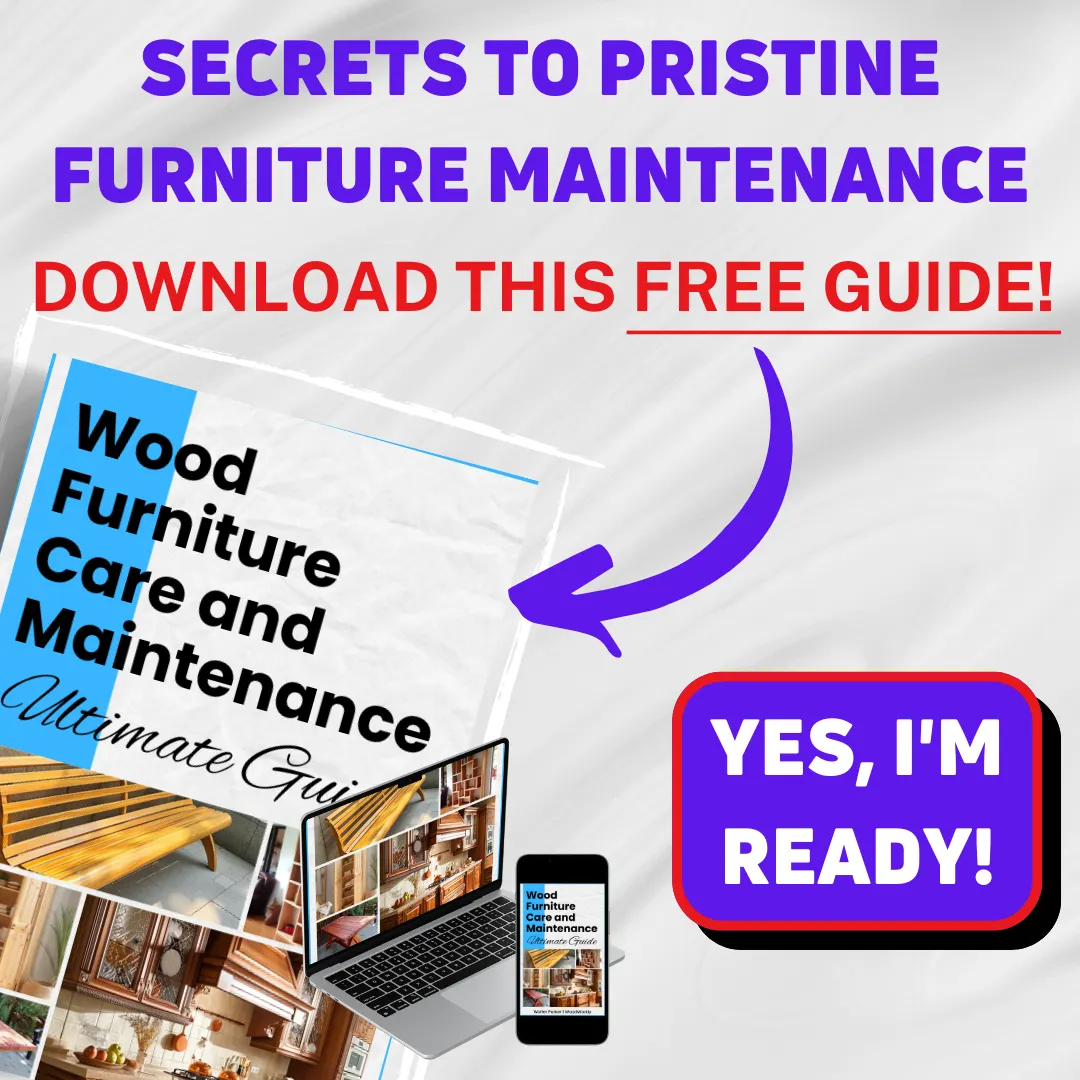
So, in this article, I’ll explore the best commercially available epoxy filler products in terms of their pros and cons, factors to consider when choosing the correct epoxy wood filler, steps to follow, and the benefits of using them.
Let’s get started!

This post contains affiliate links. As an Amazon Associate, I earn from qualifying purchases. I endorse only products I truly recommend. If you make a purchase using one of these links, I may receive compensation at no extra cost to you. For more information, see my disclosure policies.
Best Epoxy Wood Fillers
The “best” epoxy wood filler can be determined by a variety of factors, including the specific needs of your project, the type of wood you’re working with, and the qualities you value in a filler.
However, I can recommend a few well-known epoxy wood fillers known for their performance.
You will need epoxy filler,
- If removing a piece of wood causes the entire structure to collapse,
- If the workpiece has a unique design that cannot be replaced,
- If the majority of the wood parts (roughly 80%) are free of visible and structural damage

Now let’s discuss each product’s properties, benefits, and drawbacks of the product in detail.
1. Abatron WoodEpox Replacement Compound
The Abatron WoodEpox is one of the most professional, high-quality, and well-known wood fillers on the market today.
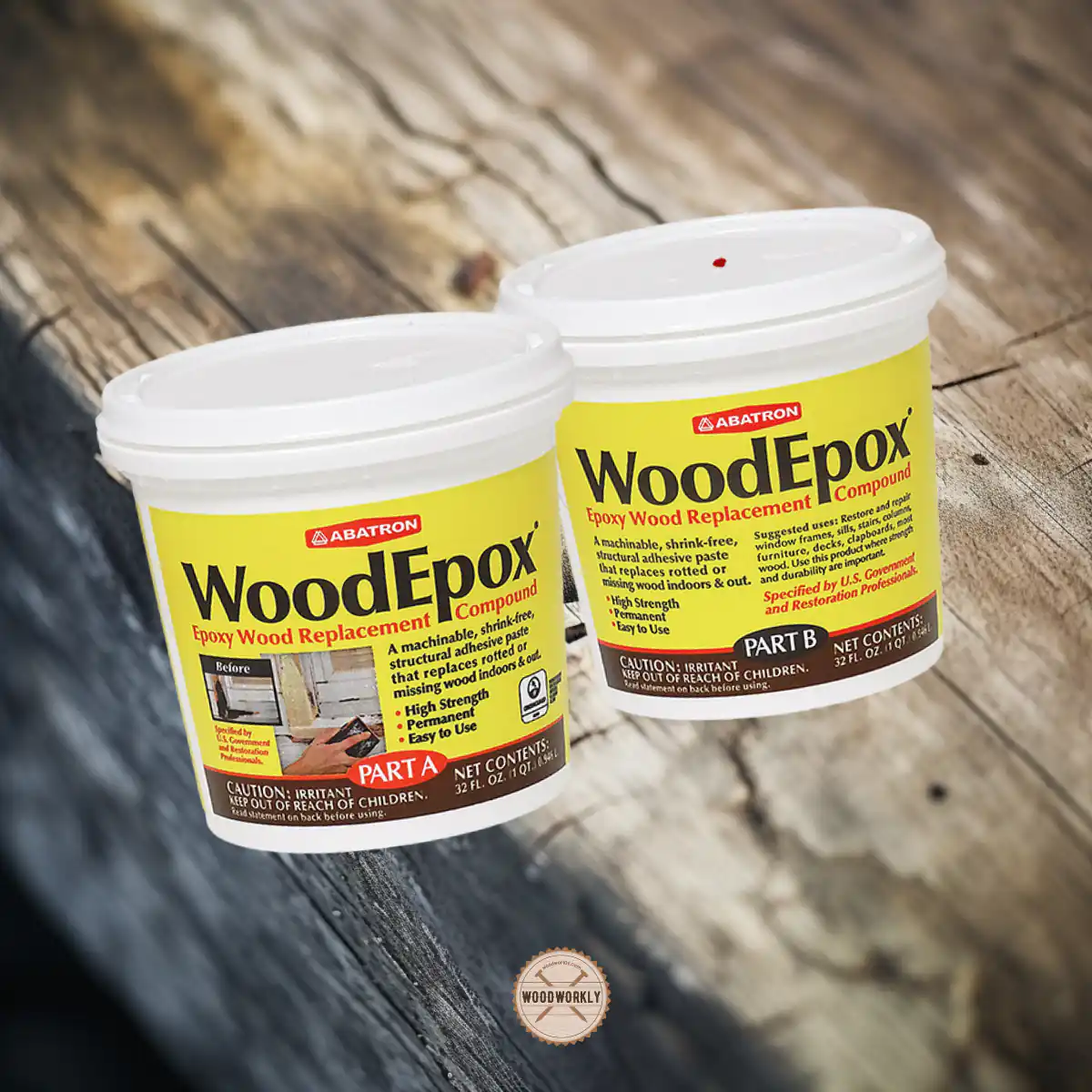
Abatron WoodEpox quickly fills wood cracks without drying too quickly, allowing you to work slowly and with attention to detail.
While it is difficult to stain, it is an excellent filler for outdoor use due to its resistance to water and sunlight.
Because epoxies are less effective on softwood, the Abatron WoodEpox isn’t suitable for every job. It works best with harder woods such as birch or oak.
Pros
- Best to fill large holes
- Highly resistant to water and sunlight
- Environmentally friendly because of low VOC (Volatile Organic Compounds)
Cons
- Difficult to stain
- Not very suitable for softwoods
- Have to mix beforehand
Read to know the Best Wood Fillers for Screw Holes (Manually Tested!)
2. Elmer’s Stainable Wood Filler
Elmers is a widely recognized household brand due to its affordability, reliability, and ease of use.
Despite its compact size, Elmer’s wood filler E887Q model is ideal for small to medium-sized projects.
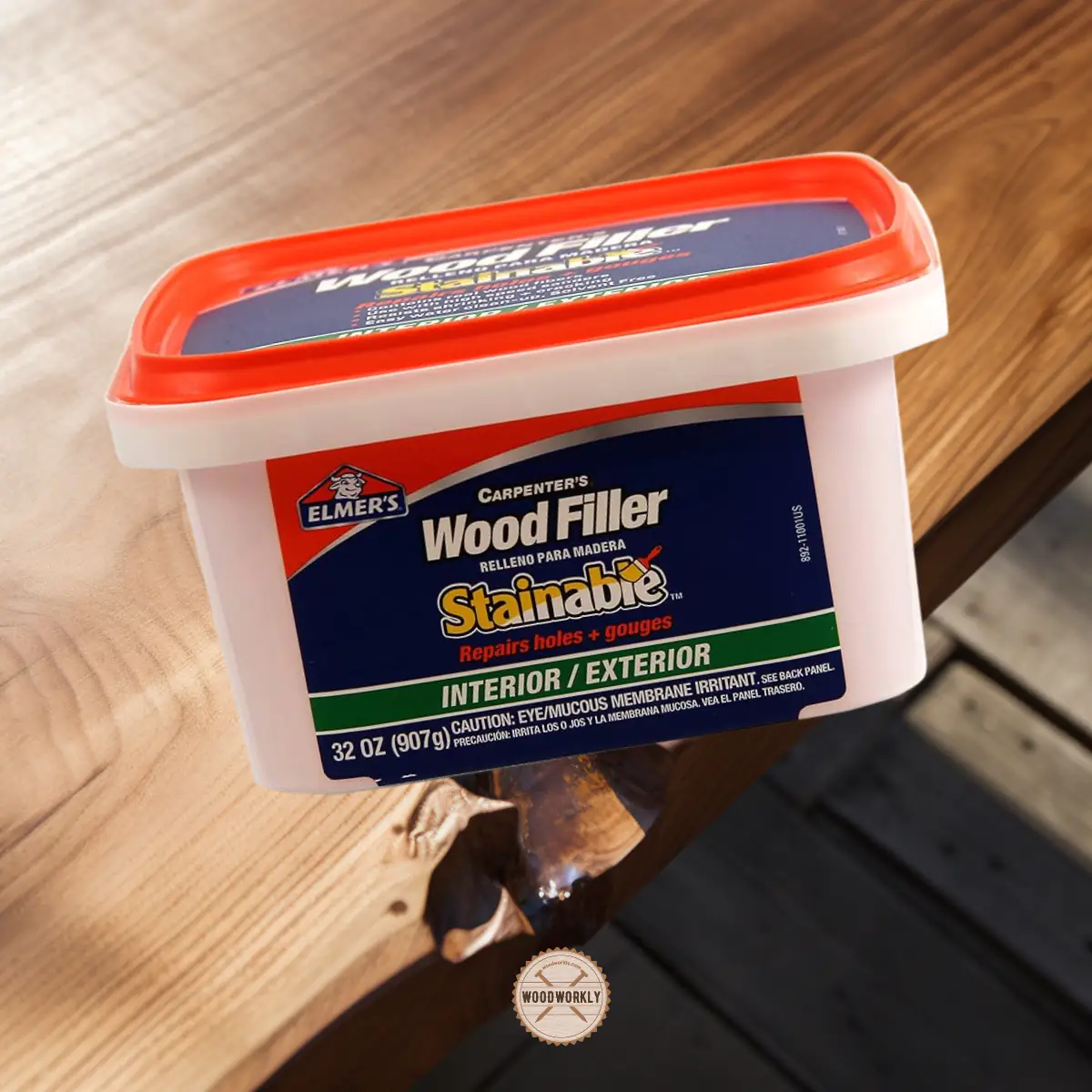
Because it contains natural wood fibers, it is ideal for filling gaps in wooden furniture and other small-scale projects.
Many woodworkers use it as an interior wood filler because it seals the surface well and doesn’t leave any gaps where water can collect. For those on a tight budget, this is the best wood filler.
Pros
- Durability and long-lasting
- Affordable price
- Well suited for small scale woodworking projects
- This filler is sandable, stainable, and paintable.
- Resist shrinking and cracking
Cons
- Color matching challenges
- Not suitable for all stains
Check out Can You Paint Over Wood Filler? (Quick and EASY Guide!)
3. Elmer’s Carpenter’s Wood Filler
The greatest option for patching damaged wood inside your house while staying within your budget is Elmer’s Carpenter’s Wood Filler Interior.
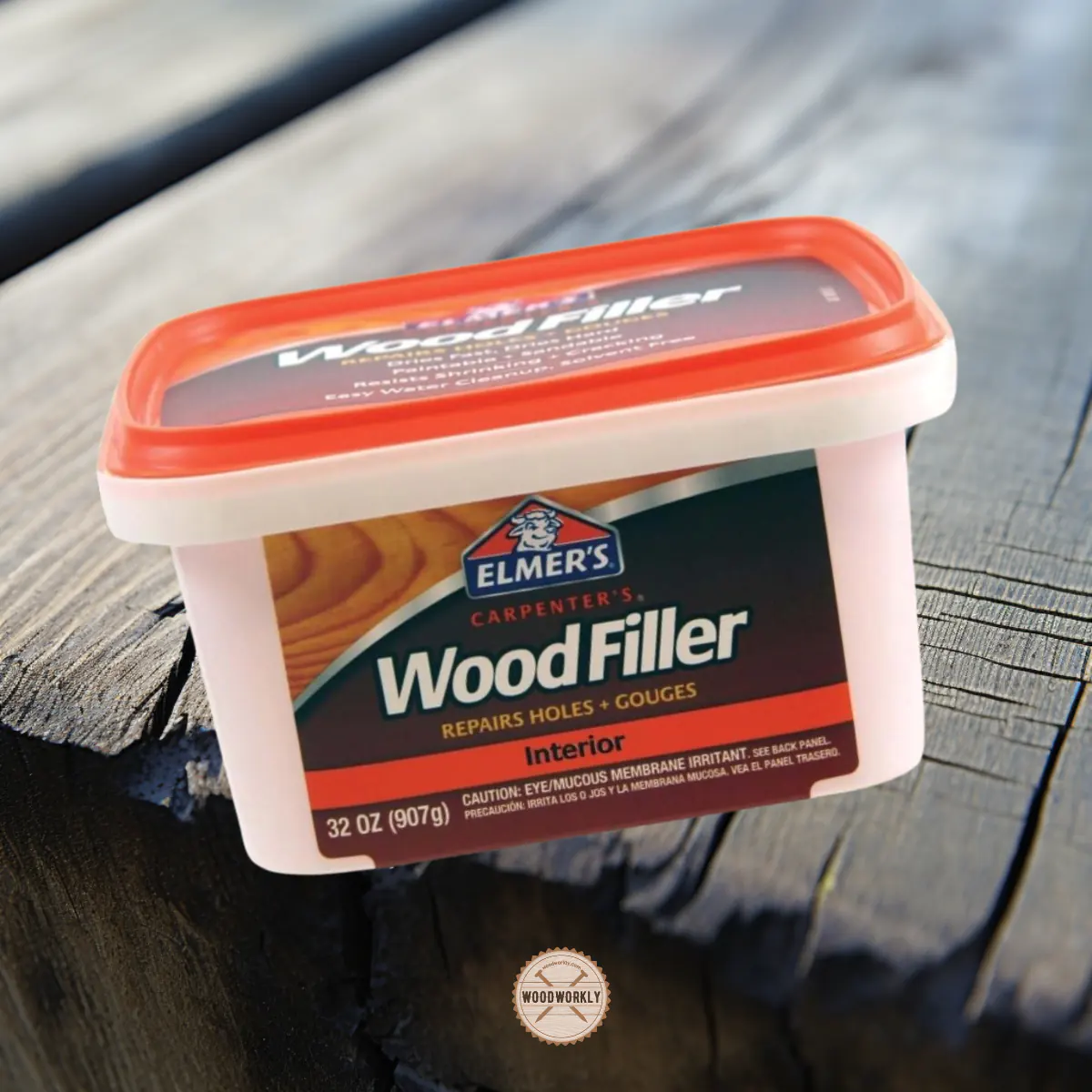
This low-odor, solvent-free wood filler dries to a smooth finish in 12 to 24 hours. Applying it to holes, splits, and cracks in your wooden surfaces—furniture, trim, or floors—is made simple by this tiny tube.
Although it can be a little more difficult to use on shallow scratches, its thick texture makes it appropriate for fairly deep holes or gouges.
Pros
- Very user-friendly
- Enough thickness to fill in deep gouges and holes easily
- Withstands shrinking and cracking
Cons
- Not water-resistant
- When opened, the tube may dry out and become clogged
- Not for external use
4. 3M Bondo Home Solutions Wood Filler
Bondo Wood Filler is a highly recommended solution for exterior wood projects if you’re looking for reliable woodworking supplies.

Restoring and reconstructing damaged or rotted wood, its two-part formula blends seamlessly to create a medium-brown shade that looks natural.
Moreover, its versatility allows it to be applied to complete gaps.
It creates a solid bond with the wood during the usually 30-minute curing process, which results in a long-lasting, waterproof repair that won’t shrink or warp.
Pros
- Highly durable bond after drying
- Able to withstand moisture
- Dries rapidly
Cons
- May cause skin irritation; use gloves when applying
- Only one color
5. Miller Wood Stain Scratch Fix Pen / Wood Repair Marker
The Miller SF1203 is ideal for covering up small stains, small gouges, and scuff marks because it dries almost instantly.
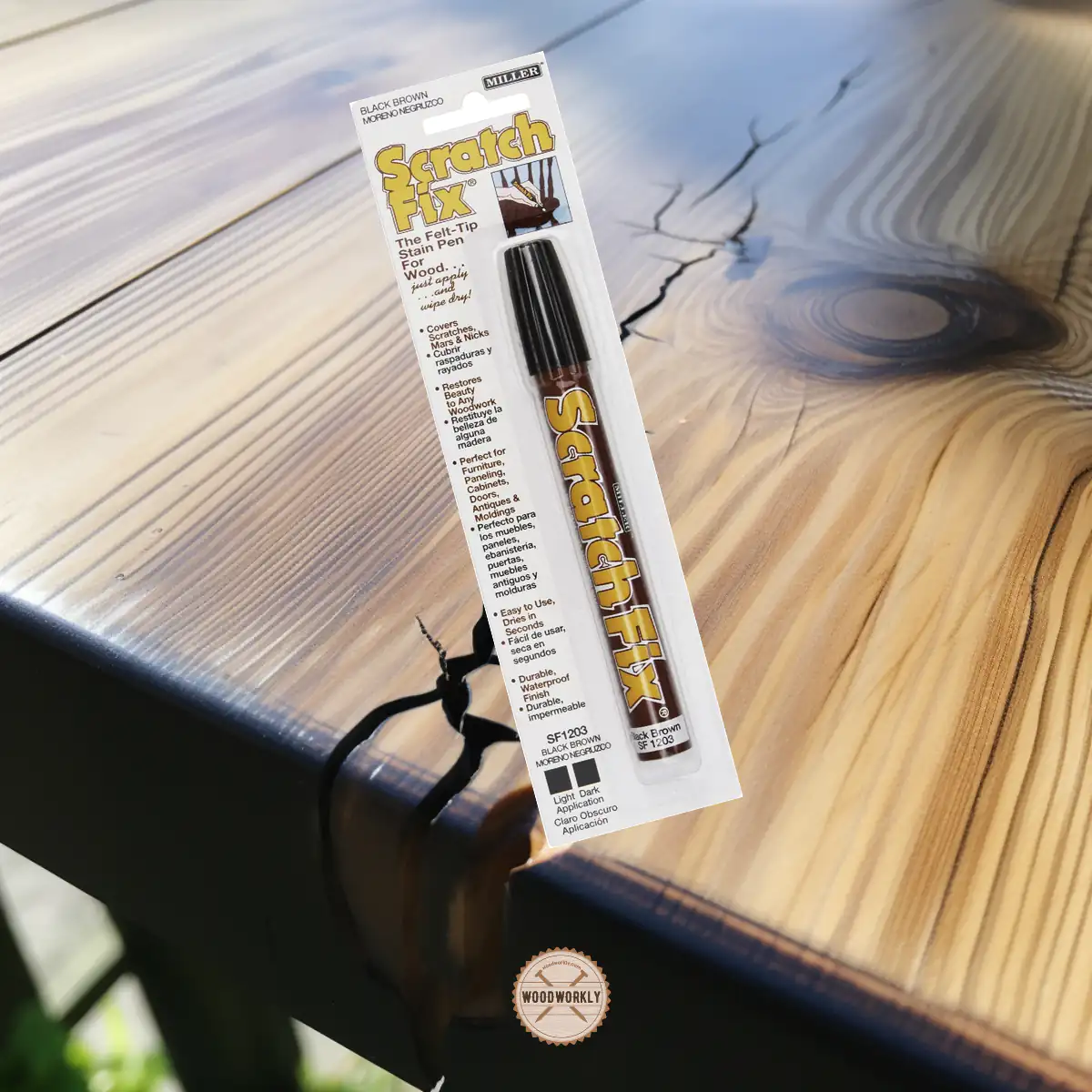
For all types of wood, it is available in five shades; the darker hues in particular tend to blend extremely naturally and subtly.
Pros
- Best suited for small woodworking projects
- Works on any kind of wood surface, including furniture and floors
- Waterproof
- Easy to use
Cons
- Limited coverage
- Not suitable for major damages
6. J-B Weld KwikWood Wood Repair
Another one of the greatest exterior wood fillers is J-B Weld Wood Restore Epoxy Putty.
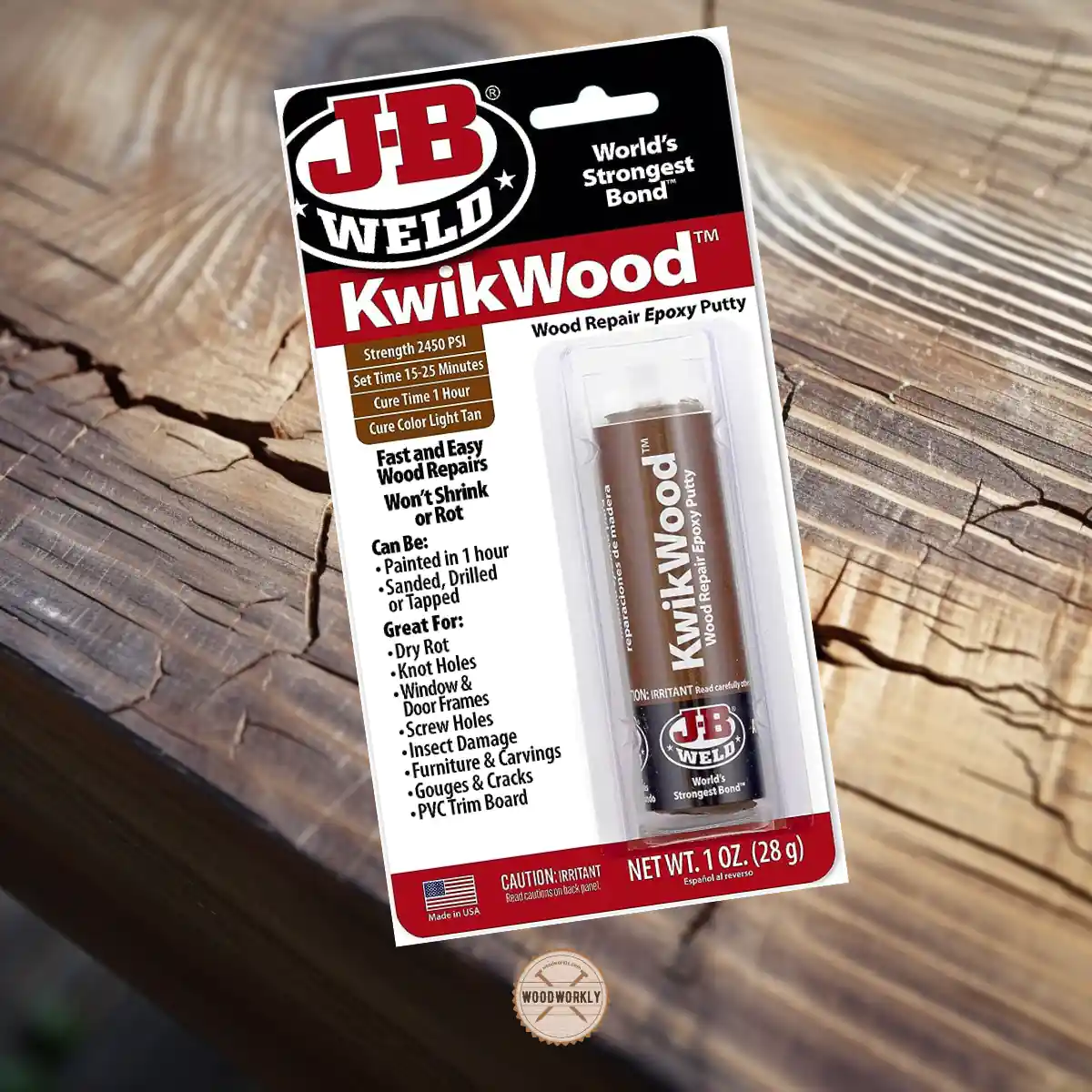
This wood putty is perfect for outdoor projects because it is as strong and durable as the PC Woody Wood Repair and Abatron wood fillers mentioned above.
Pros
- High strength and durability
- More readily accepts paint and stains than other fillers
- Good value for the price
- More readily accepts paint and stains than other fillers
Cons
- Need to mix thoroughly before using
7. J-B Weld Wood Restore Epoxy Putty Kit
J-B Weld produces a stronger epoxy wood filler. One of their flagship products, its unmatched power and dependability make it highly sought after by expert woodworkers.
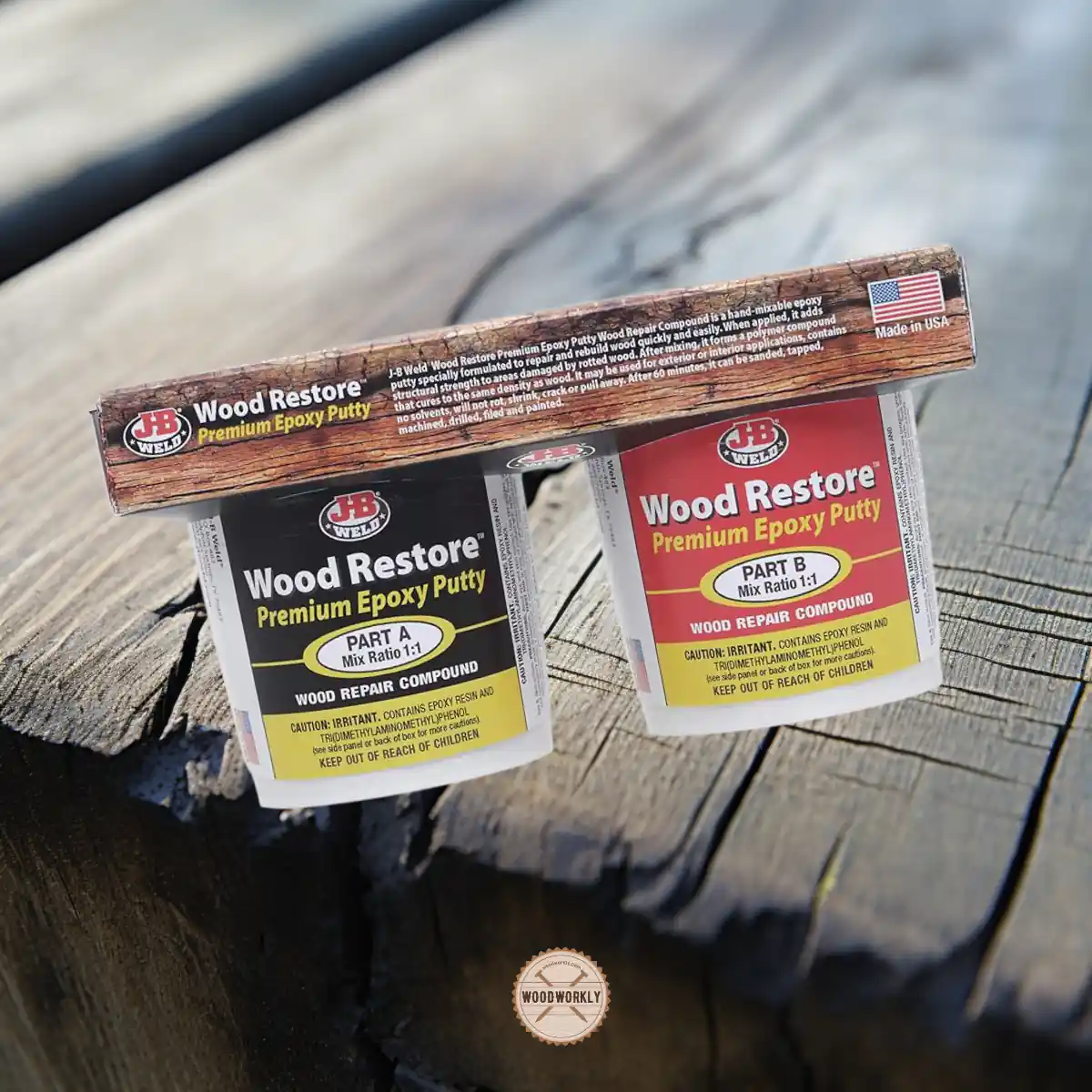
It comes in two parts: the resin and hardener, which you will need to mix yourself before using it, just like many professional epoxies.
Similar to natural wood, it can be precisely shaped, machined, and sanded down. It dries quickly and takes less than one hour to fully set.
Pros
- Suitable for heavy-duty jobs
- Fast-setting epoxy
- Creates an ultra-high-strength bond
- Suitable for repairing rotted or damaged woods
Cons
- Difficult to undo once cured
8. Minwax Color-Matched Wood Filler
You can use Minwax® Color-Matched Wood Filler for imperfections in finished wood without sanding.

Their ready-to-use mixture is perfect for fixing gouges, knot holes, nail holes, and other imperfections in any kind of indoor or outdoor wood surface, finished or unfinished.
It behaves and looks like real wood and is perfect for fixing gouges, knot holes, nail holes, and other imperfections in any kind of indoor or outdoor wood surface, finished or unfinished.
Here are some pros and cons of the product.
Pros
- Cures more quickly
- Simple to use
- Dries to a natural look
- Minimal sanding required
Cons
- A little slow dry time

What to Consider When Choosing an Epoxy Wood Filler
Selecting the appropriate epoxy wood filler is essential to accomplishing a successful and long-lasting repair.
When choosing an epoxy wood filler, I recommend you consider the following factors.
Type of Repair
Identify the exact type of repair that needs to be done.
Different formulations of epoxy wood fillers are available; some are appropriate for minor holes and cracks, while others are made for more substantial repairs or structural bonding.
Strength of Bond
Analyze the epoxy filler’s adherence and bonding strength. Make sure it creates a solid bond with the wood surface to stop future separation or cracking.
Drying Time
Think about how long the epoxy filler will take to dry. While some formulations cure more slowly than others, some dry quickly. Select a product whose drying time fits the needs of your project.
Adaptability
You may require an epoxy filler with some degree of flexibility, depending on the application.
This is crucial for repairs in places where the wood might be moving or expanding and contracting.
Resistance to Water and Weather
Examine the epoxy filler’s resistance to water and weather, particularly if the repaired wood will be left outside.
For external applications, an epoxy that is waterproof or water-resistant is necessary.
Color Coordination
Select an epoxy filler that can be readily painted or stained to blend in with the surrounding wood.
While some epoxy fillers are color-coded, others can be painted or stained once they have dried.
Price
Although traditional latex wood fillers are less expensive than epoxy wood fillers, there is still variation in the cost of various epoxy fillers.
The best epoxy wood fillers, in my experience, will run you $30 or more, while some basic fillers can be purchased for less than $10.

Pros and Cons of Epoxy Wood Filler
Wood surfaces can be repaired and restored with epoxy wood fillers. The following are the benefits and drawbacks of using epoxy wood filler.
Advantages
- Strong Adhesion: They provide High-strength, long-lasting repairs that resist shrinkage or cracking.
- Water and pest Resistance: This makes them an excellent choice for outdoor woodworking projects.
- Flexibility: Once cured, epoxy wood fillers can be sanded, drilled, painted, or stained just like regular wood, offering a high degree of flexibility in the finishing process.
- Ease of Shaping and Sanding
- Provide color Matching Options
Disadvantages
- Odor: During the application and curing processes, epoxy fillers may emit an odor. When working with these products, adequate ventilation is recommended.
- Cost: Epoxy wood fillers typically cost more than other types of wood fillers. This is something to think about for budget-conscious woodworkers or large-scale projects.
- Staining Challenges: Although many epoxy wood fillers can be stained, matching the existing wood finish can be difficult.
How to Use Epoxy Wood Filler
One popular technique for repairing and restoring wooden surfaces is the use of epoxy wood filler.
Here is a general procedure to how-to use epoxy wood filler
1. Gather All the Tools and Materials
First, gather the following simple items before starting the process.
- Sandpapers
- Putty Knife
- Epoxy Wood Filler
- Safety Gear: Gloves and safety glasses
2. Prepare the Wood
To get rid of any dirt, debris, and loose wood particles, clean your damaged area well.
In order to improve the bonding surface of the epoxy filler, use sandpaper to roughen the damaged area.
If the wood is bare, make sure it is clean and devoid of any wax or finish that may hinder adhesion.
3. Mixing the Epoxy Filler
When mixing the epoxy wood filler, adhere to the manufacturer’s instructions.
The majority of epoxy fillers are composed of two components, a hardener and a resin, which need to be combined in specific ratios.
Read to know, Does Wood Filler Harden? Debunking the Myths!
To ensure a uniform color and texture, thoroughly mix the filler.
4. Apply the Exterior Epoxy Wood Filler
Apply the combined epoxy filler to the damaged area using a putty knife or you can use a spatula. Smooth out the filler after pressing it into the damaged wood.
5. Shaping and Sculpting
While the epoxy is still pliable, shape or sculpt the repair area if necessary.
To help with shaping and to keep the epoxy from sticking, moisten your fingers or the putty knife with water.
6. Allow It to Dry
As directed by the manufacturer, let the epoxy filler dry. Usually, this will take a few hours to overnight depending on the product.
Remember not to disturb it when the repair area is drying.
7. Finishing
After the epoxy has fully dried, smooth the repaired area with fine-grit sandpaper. Sand the filler until the surrounding wood and filler are flush.
To repair, blend in perfectly with the original wood, and feather the edges. If necessary, paint or stain the repaired area to blend in with the nearby wood.
To give the repaired area protection and a uniform appearance, you can apply a finish or sealant.

That’s it folks! Now you know all the best epoxy wood fillers available in the market based on their properties, purposes, pros and cons.
Now you can easily select the one that suits you the most based on your project type.
So, let’s answer some frequently asked questions.
FAQs
What is the best epoxy wood filler for outdoor use?
The 3M Bondo Home Solutions Wood Filler is highly recommended for exterior use due to its durability and resistance to weather conditions.
Can epoxy wood fillers be painted or stained?
Yes, most epoxy wood fillers like Elmer’s Stainable Wood Filler and J-B Weld Wood Restore Epoxy Putty Kit can be painted or stained, although some may require specific types of paint or stain.
Are there any budget-friendly epoxy wood fillers that offer good quality?
Elmer’s Carpenter’s Wood Filler is a budget-friendly option that provides good quality for small-scale indoor wood repairs.
How long does it take for epoxy wood fillers to dry?
Drying times vary; for instance, J-B Weld KwikWood Wood Repair sets quickly, while others may take a few hours to cure fully.
Is there an epoxy wood filler suitable for both interior and exterior use?
The Abatron WoodEpox Replacement Compound is suitable for both interior and exterior applications, offering high-quality repairs in various settings.
Can epoxy wood fillers be used on different types of wood?
Yes, products like Minwax Color-Matched Wood Filler are versatile and can be used on various wood types, including hardwood, softwood, and plywood.
Are there any epoxy wood fillers that are easy to apply for beginners?
The Miller Wood Stain Scratch Fix Pen/Wood Repair Marker is known for its easy application, making it suitable for beginners.
Did I cover all you wanted to know about: Best Epoxy Wood Fillers
In this article, I deeply discussed the best epoxy wood fillers available with their qualities in detail.
The best epoxy wood fillers are Abatron WoodEpox for high quality, Elmer’s Stainable Wood Filler for overall performance, and 3M Bondo for exterior use. Elmer’s Carpenter’s offers a budget-friendly option, while Minwax Color-Matched excels in color matching, and J-B Weld KwikWood is ideal for fast setting applications.
Make sure to select the epoxy wood filler not considering their price, but the outcome they produce. That’s how you can get promising results.
Hope you learned everything you wanted to know about, the best epoxy wood fillers including expert tips!
Now start repairing your beautiful furniture like a pro with the best epoxy fillers!